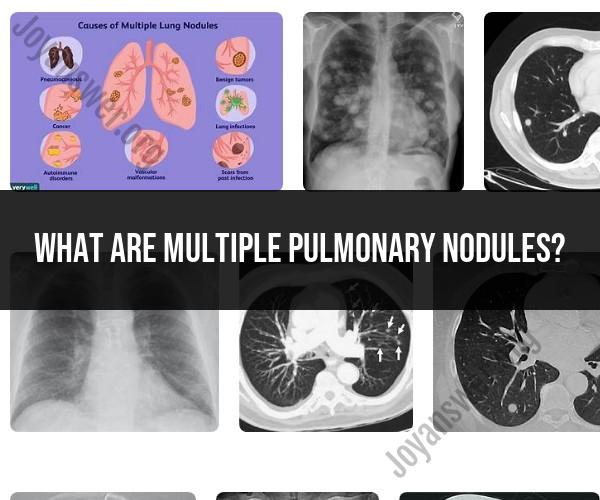What are multiple pulmonary nodules?
Multiple pulmonary nodules are small, round or oval growths in the lungs. These nodules can vary in size and are typically detected through medical imaging, such as chest X-rays or computed tomography (CT) scans. The presence of multiple pulmonary nodules can be a cause for concern and requires evaluation to determine their nature and potential causes.
Here are some key points to understand about multiple pulmonary nodules:
Appearance: Pulmonary nodules typically appear as small, well-defined, and rounded or oval-shaped abnormalities in the lung tissue. They can range in size from a few millimeters to a few centimeters.
Possible Causes:
- Benign Nodules: Not all pulmonary nodules are cancerous. In fact, many nodules are benign (non-cancerous) and may result from various non-malignant conditions, such as infections, scars from prior infections, or non-cancerous growths (hamartomas).
- Malignant Nodules: Some pulmonary nodules are cancerous (malignant). They may represent primary lung cancer or metastases from cancer originating in other parts of the body.
Evaluation and Diagnosis:
- When multiple pulmonary nodules are discovered, further evaluation is necessary to determine their nature. This typically involves follow-up imaging, such as CT scans, over a period of time to assess any changes in size or appearance.
- Biopsies, typically obtained through procedures like bronchoscopy, needle biopsies, or surgical biopsy, may be recommended if there is a strong suspicion of malignancy or if the nodules continue to grow or change over time.
Risk Factors:
- Risk factors for pulmonary nodules include a history of smoking, exposure to environmental toxins or occupational hazards, a history of cancer, and certain lung conditions or infections.
Management and Treatment:
- The management and treatment of multiple pulmonary nodules depend on their diagnosis. Benign nodules may require no treatment or further monitoring. Malignant nodules may involve treatment options such as surgery, radiation therapy, chemotherapy, or targeted therapies.
Follow-Up Care:
- For individuals with pulmonary nodules, regular follow-up care is essential to monitor any changes in nodule size or characteristics. This helps in the early detection and management of potential malignancies.
It's important to note that not all pulmonary nodules are cancerous, and many benign nodules do not require immediate or aggressive treatment. The evaluation of multiple pulmonary nodules should be carried out by a healthcare professional, typically a pulmonologist, radiologist, or oncologist, who will use various diagnostic tools and clinical judgment to determine the appropriate course of action based on the specific characteristics of the nodules and the patient's medical history.
What are multiple pulmonary nodules, and what do they indicate?
Multiple pulmonary nodules are two or more small, round growths in the lungs. They can be seen on imaging tests such as X-rays, CT scans, or PET scans. Pulmonary nodules can be benign (non-cancerous) or malignant (cancerous).
What causes the development of pulmonary nodules in the lungs?
There are many different causes of pulmonary nodules, including:
- Infection: Pulmonary nodules can be caused by infections such as tuberculosis, pneumonia, and histoplasmosis.
- Inflammation: Pulmonary nodules can be caused by inflammatory conditions such as sarcoidosis and rheumatoid arthritis.
- Autoimmune disorders: Pulmonary nodules can be caused by autoimmune disorders such as Wegener's granulomatosis and systemic lupus erythematosus.
- Environmental exposures: Pulmonary nodules can be caused by exposure to environmental toxins such as asbestos and secondhand smoke.
- Cancer: Pulmonary nodules can be caused by cancer, such as lung cancer, lymphoma, and melanoma.
How are multiple pulmonary nodules diagnosed and evaluated?
Multiple pulmonary nodules are typically diagnosed incidentally, meaning that they are found on an imaging test that was ordered for another reason. Once multiple pulmonary nodules are found, the doctor will need to determine whether they are benign or malignant.
This may involve additional tests such as:
- Blood tests: Blood tests can be used to look for signs of infection or inflammation.
- Sputum tests: Sputum tests can be used to look for signs of infection.
- Bronchoscopy: Bronchoscopy is a procedure in which a thin, flexible tube is inserted through the nose or mouth into the lungs. This allows the doctor to look at the inside of the airways and collect samples of cells or tissue for testing.
- Lung biopsy: A lung biopsy is a procedure in which a small sample of tissue is removed from the lung and tested for cancer.
What treatment options are available for patients with multiple pulmonary nodules?
The treatment for multiple pulmonary nodules will depend on the underlying cause. If the nodules are benign, no treatment may be necessary. If the nodules are malignant, treatment will depend on the type of cancer and other factors.
Treatment options for cancer include:
- Surgery: Surgery may be used to remove the nodules.
- Radiation therapy: Radiation therapy uses high-energy rays to kill cancer cells.
- Chemotherapy: Chemotherapy uses drugs to kill cancer cells.
- Targeted therapy: Targeted therapy uses drugs that target specific molecules involved in cancer growth.
Can you explain the significance of monitoring and follow-up for pulmonary nodules?
Monitoring and follow-up are important for patients with multiple pulmonary nodules, even if the nodules are benign. This is because some benign nodules can develop into cancer over time.
Monitoring and follow-up may involve regular imaging tests and blood tests. The frequency of monitoring will depend on the size and appearance of the nodules, as well as the patient's overall health.
If the nodules change in size, shape, or appearance, the doctor may recommend additional tests or treatment.
Please note that this is general information and is not intended to be a substitute for professional medical advice. If you have any concerns about multiple pulmonary nodules, please talk to your doctor.












